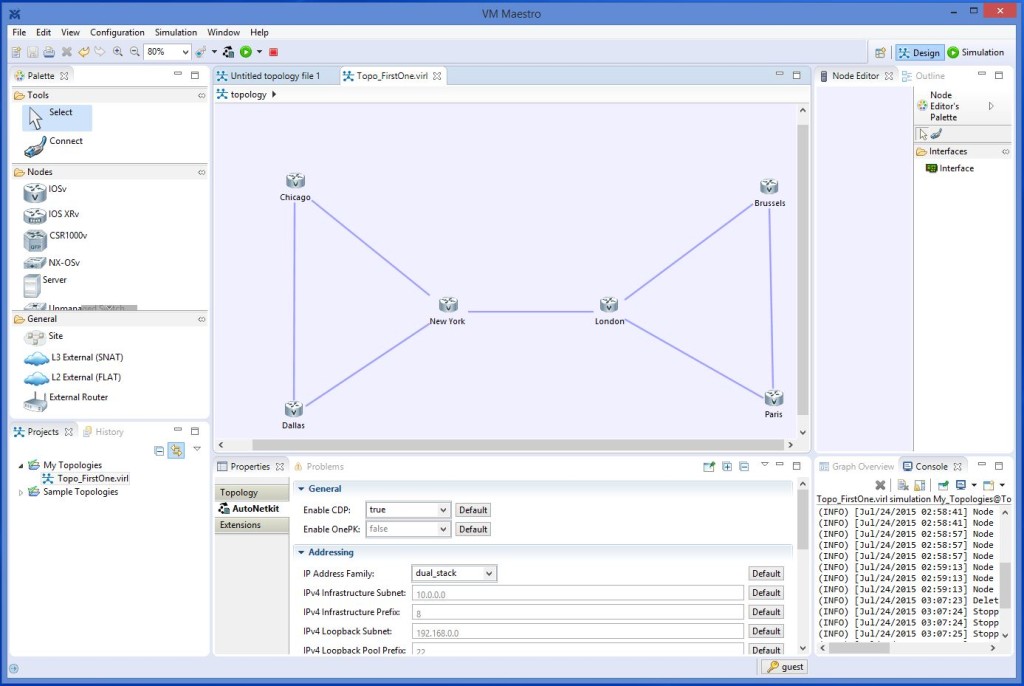My home PC is over 7 years old, and let me tell you…it was past time for an upgrade. I’ve been running Photoshop and Lightroom, along with an old version of VMware Workstation…talk about old and s-l-o-w! I started planning for a new PC earlier this year, but wasn’t really in a rush…just sort of waiting for something to push me over the edge…the “time to buy” edge.
Well, that edge was Cisco VIRL (Virtual Internet Routing Lab). One of the classes I attended at this years CiscoLive in San Diego concerned Cisco’s efforts in virtual network simulation. They have a commercial product (CMD – Cisco Modeling Labs), and they have a personal edition (VIRL). CMD is very expensive…as in, well…VERY. However, VIRL is reasonably priced…$200/year (it’s subscription based). VIRL is incredibly powerful and flexible; you can design and run many different types of simulated networks, all running real Cisco IOS (IOSv actually…a virtualized version of IOS). There is a limit of 15 nodes though…yes, that’s not really enough, but it does let you do a lot of testing and learning. (Visit here for more info on VIRL.)
Back to my PC. There was NO way it would ever be able to run VIRL…so I just had to buy a new one. 🙂
As you can tell, I don’t buy new PC’s often, so I wanted to make sure they last. The specs on my new PC…
- Intel i7 Quad-core processor (3.6 Ghz)
- 32 GB of RAM (VIRL loves RAM!!)
- Nvidia Graphics card with 4 GB RAM
- 1 TB hard drive
- 256 GB Samsung 850 PRO SSD drive (I added this in myself)
Wow…let me tell you…this thing rocks! And I spent today installing and running VIRL. (This is not an easy installation…you really need to follow directions, but it’s not really that difficult. Knowing your way around Linux sure helps though.) Here is a screen shot of VIRL with 6 routers configured…
I have just scratched the surface of VIRL…it is incredibly complex, but that’s ok…I have a lot to learn, but the rewards will be well worth it. I will post more about VIRL soon.


Very Cool!!!!
So you mentioned Linux above, are you running this on a virtual Linux machine or side-loading Linux with Windows or?
The PC is running Windows 8.1, and on that I’m running VMware Workstation. The actual network simulation software from Cisco is an OVA file (which is a fully configured server instance) that is Linux based, and runs on top of the VMware Workstation. Getting it all to work took a bit of time, but since I know Linux, I was able to poke around the Cisco VIRL server quickly.
Very cool. I didn’t know about this virl. I always appreciate you teaching me about some good stuff.
Hi Brad,
Can you let me know how much memory is used when virl is pushed to about 10 routers. I currently use gns3 for my ccie studies still as it seems more then sufficient rather then having to splash out for virl but may look at this option if i can get away with upgrading my ram currently at 8gb.
Hi Zabeel…let me see if I can test that out. Not sure yet, as I’m still getting used to VIRL and learning how it works. I’ll try and get back to you in the next day or two. -Brad
Thanks Brad much appreciated for the response 🙂
Hi Zabeel,
I am sorry for the long delay. I’ve been sick most of last week and I’m just now getting back into the swing of things.
Before purchasing VIRL I did a lot of research on this (there is a lot of opinions out there), and basically you will get the following performance with a host system running a Quad core CPU…
8 GB RAM: 6-8 IOSv routers
16 GB RAM: 15 IOSv routers (which is the max allowed within VIRL)
This isn’t bad at all, but realize this is just running the basic IOSv routers…if you were to run some of the other devices (IOSvL2, NX-OSv, CSR1000v, etc), they use more RAM than the IOSv routers, and the size of your simulations would be reduced.
My opinion: I highly recommend 16 GB of RAM…and even more if you can afford it (24 or 32). You can get away with 8 GB but your simulations would be limited in scope, especially if you want to run a mix of devices, and it will probably run a bit sluggishly.
Hope this helps!
Brad
Many Thanks Brad.
It looks like I will need to buy a new pc with 16GB as minimum before investing in VIRL as running a mix of ISE which uses 4gb and other virtual devices such as F5 it all takes a toll on memory.
Thanks for taking time out for investigating this for me 🙂 much appreciated.
For now I will continue to watch your updates.
All the best.
Regards
Zabeel